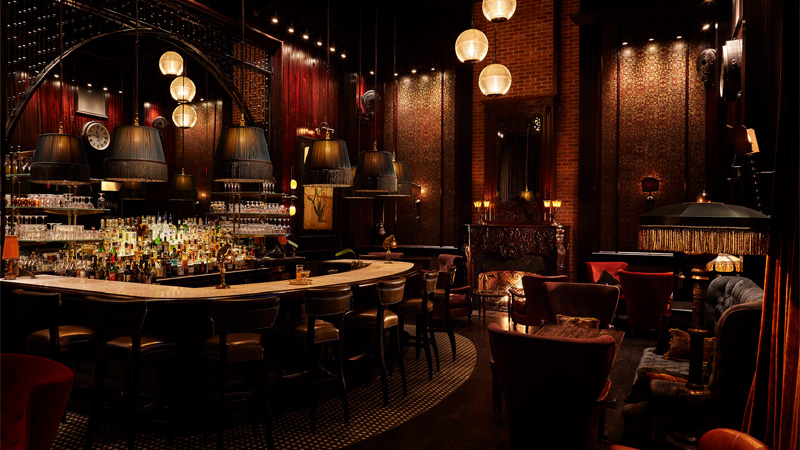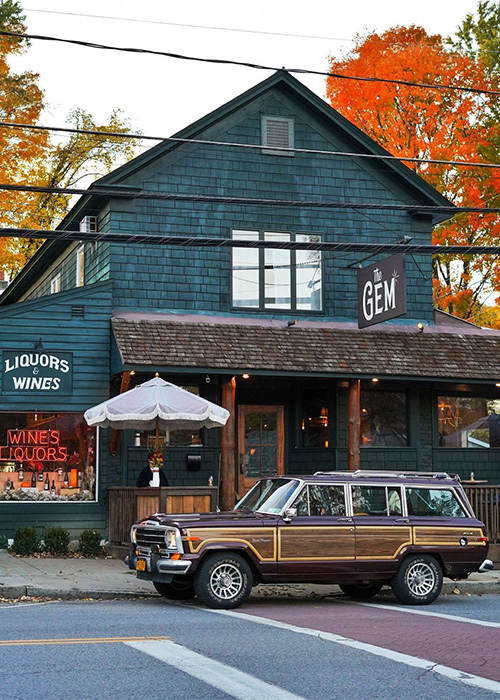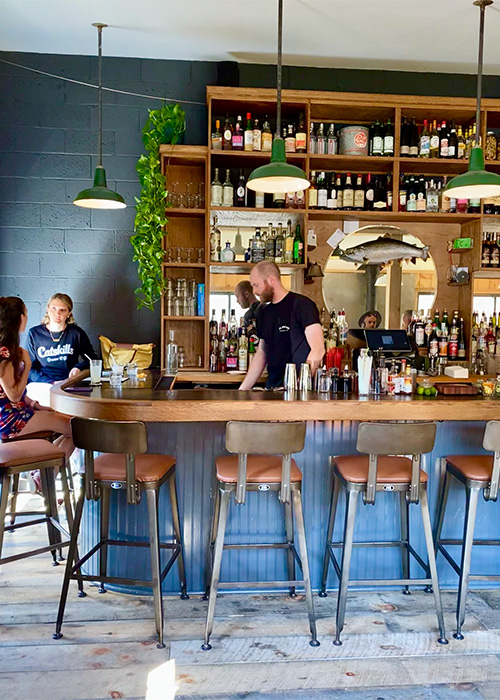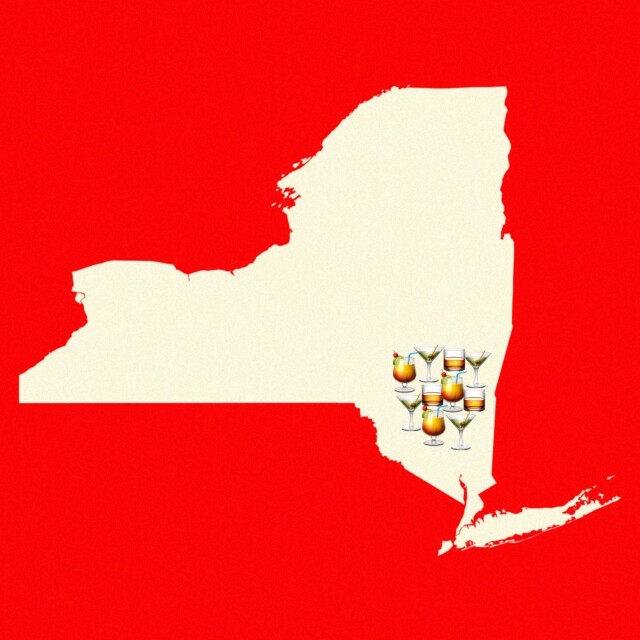In 2018, David Wondrich walked into a cocktail bar. That, in and of itself, wasn’t news. The noted cocktail historian walks into plenty of bars. What made this visit unusual is where the bar was: Cochecton, N.Y., a hamlet of 1,320 people on the Delaware River. The bar was called Cochecton Fire Station, after the decommissioned firehouse it occupied.
The owners, Josiah Early and Ezekiel Miller, knew Wondrich from their days working at Flatiron Lounge, the famous cocktail bar in Manhattan (now closed), and were flabbergasted to see him out of his usual New York City context.
“What are you doing here?” they asked Wondrich.
“What are you doing here?” he retorted.
It was a good question. Wondrich had an excuse: He was staying at a property his family owns just miles away. Early and Miller’s explanation was a little more complicated.
After spending weekends upstate maintaining a friend’s house, and consulting on the drinks menus at a couple restaurant projects run by chef Henning Nordanger in Cochecton and nearby Callicoon, the two men began thinking of opening their own cocktail bar. When an old fire station went on the market at a bargain price, they pounced on the property.
“You start to look for an area where there would be more excitement for cocktails, and genuine appreciation of them,” says Early. And there was appreciation. Plenty. The cocktails were a hit with locals from the start. “Everybody wanted to try them. It’s all in the delivery. We loosened the cummerbunds and stripped it back to just making cocktails. We bartended in T-shirts and sweatshirts.”
Ten years ago, a New Yorker who hopped on a train or in a car headed north would expect, with every passing mile, to get farther and farther away from any hope of finding a finely wrought mixed drink. Upstate New York was a land of wine and beer and maybe the occasional, workmanlike Martini or Manhattan.
But that is no longer the case. Upstate New York now has a wealth of craft cocktail destinations.
“The bar and restaurant scene has exploded in the past few years,” says Natasha David, who has overseen several upstate cocktail programs since moving to the Dutchess County village of Red Hook in 2017. At this point, she can be considered an OG upstate cocktail figure. She currently has a hand in the drink programs at Casa Susanna in Leeds and Rivertown Lodge in Hudson. She is also helping C. Cassis, a liqueur maker in Rhinebeck, which just opened a new tasting room.
“So many wonderful new additions, and much to my chagrin, getting reservations can be tough,” David says.

It was only natural that the craft cocktail revival would eventually creep up the Hudson River. Bartenders are no different than any other kind of New York City worker. They get older, get married, have children. Suddenly the quieter life and slower pace of upstate begins to look attractive. Once the bar pros move north, they don’t stop plying their trade. They just start doing it locally.
The Covid-19 pandemic accelerated this process, causing even more mixologists to seek the relative safety of semi-rural New York State. As a result, the daytripper can now find top-notch craft cocktail programs not only in expected mid-sized markets like Hudson (The Maker Lounge); Beacon (The Roosevelt Bar); and Kingston (Stockade Tavern), but also at such far-flung and disparate hamlets as Cochecton; Catskill (the bar Hemlock, which opened this past summer); Bolton Landing (The Gem, 2022), and Roscoe (The Junction, 2021). These watering holes are owned and run by bartenders who used to work — and in some cases still do — at noteworthy New York City cocktail destinations, past and present, like Diamond Reef, Employees Only, Flatiron Lounge, Dutch Kills, Nitecap, and Smith & Mills.
The pioneer in this movement was Sasha Petraske, the late founder of the legendary Milk & Honey in NYC. In 2014, he was brought up to Hudson as a consultant on Wm. Farmer & Sons, a hotel, restaurant, and bar founded by the husband and wife team of William Kirby Farmer and Kristan Keck.
“Farmer was definitely a forerunner,” says Pia Bazzani, who is currently the food and beverage director at The Maker Lounge in Hudson, and previously ran a cocktail bar in Kingston called Crown Lounge.
“I think finding that balance between craft cocktails and unpretentiousness is key — great drinks but in an unstuffy setting.”
Petraske did not live to see the craft cocktail movement bloom upstate. He died suddenly in Hudson in August 2015, making Wm. Farmer the final cocktail program he created. After his death, work at Wm. Farmer was taken over by Petraske acolyte and Dutch Kills owner Richard Boccato, who still plays a limited role at Farmer today and trains new hires.

Boccato himself eventually caught the upstate bug, opening The Gem in Bolton Landing, along the shores of Lake George, in the summer of 2022.
Opening a serious cocktail bar among the winding roads and quaint villages of upstate New York is a delicate balancing act. Bar owners seek to serve drinks that would stand toe-to-toe with any Manhattan tipple, but they take care to do so without any New York attitude.
“Things move a little slower up here,” says David. “We take our time with things and emails don’t always get answered within 24 hours. I think finding that balance between craft cocktails and unpretentiousness is key — great drinks but in an unstuffy setting.”
Adam Minegar, owner of Hemlock in Catskill, worked at Diamond Reef in Brooklyn before moving upstate. Chad Arnholt, another Diamond Reef veteran, works alongside him. “Not being a big city guy and alienating the locals was super important,” Minegar says. As with most upstate cocktail bars, Hemlock’s clientele is a mix of locals, weekenders, and tourists. “This is an everybody bar,” he continues. “We have to serve everybody.”
Minegar maintains an all-are-welcome feel through every aspect of the bar, from the music soundtrack to the food menu, which includes popular fare like pimento cheese, fries, and a smash burger.
“It’s a really great area to have a cocktail program. You can pull from a lot of local places — the local farms, the produce — to make syrups and shrubs. I try to include local liquors and beers.”
Misty Hackworth and Aaron Blakely opened their bar, The Junction, in Roscoe in Sullivan County. “The more we floated around the idea to friends, the more we realized there was nothing that resembled a cocktail bar around here at all,” says Blakely, who worked at Smith & Mills in Manhattan for many years. “It was all either really fancy or pizza and wings.”

Roscoe is a famous fishing destination. To make sure anglers knew they were welcome at The Junction, the owners gave drinks cheeky names like Acid Factory, named for a popular fishing spot along Beaverkill River, and Dry Dropper, after a fly-fishing technique.
Blakely and Hackworth kept the fish fans in mind when planning out their food menu, too. Food is an important element at most of these cocktail bars because, in many upstate towns, it is difficult to find a hot meal after 8 p.m. The Junction is open until midnight and keeps serving chili cheese dogs until then. (Up until 9 p.m., there are many other things to eat, including a chicken sandwich, a grain bowl, and shishito peppers.) Hemlock also serves food until 10 p.m., as well as hot dogs until closing. “There must be food,” says Minegar. “It’s pointing people in our direction.”
Often, the food served is made with local ingredients. The same goes for the cocktails. “It’s a really great area to have a cocktail program,” says Bazzani of Maker Lounge. “You can pull from a lot of local places — the local farms, the produce — to make syrups and shrubs. I try to include local liquors and beers.”
By this measure, most upstate cocktail bars beat city saloons that boast of a “farm to glass” drinks philosophy.
“We are spoiled, because we have direct access to incredible farms with spectacular produce, freshly baked breads, cheeses, etc.,” says David. “People are used to high-quality ingredients.”
While the number of quality cocktail bars upstate has certainly mushroomed recently, it would still, perhaps, be a stretch to say that it resembles a cohesive cocktail community. Bars and bartenders are aware of one another’s activities but tend to stick to their own towns. Often, they keep the same hours, precluding visits to other bars.
“In my experience,” says Blakely, “we’re all a little bit by ourselves. We like each other’s Instagram, but that’s about it.”
Early agrees. “We all have our little bubbles, we have all our little worlds we live in,” he says. “There’s no keeping up with the Joneses.”
He also points out another reason upstate bar owners don’t bar hop — and one of the advantages of owning a bar tavern: He can be home and in bed by 9:30.
